Posts Tagged “Mechanical”
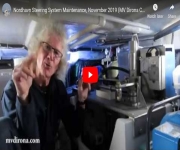
Here we step through the steering system on the Nordhavn 52, showing some of the wear points and the changes we have made to minimize these issues. Finally, we show the removal and replacement of the hydraulic steering rod end. This is the part that transfers force between the hydraulic cylinder and the steering arm….
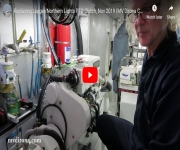
Many small Lugger marine engines and Northern Lights generators are equipped with a power takeoff (PTO) unit that can be used to drive accessories. Hydraulic pumps are a common use case for this PTO. These PTOs are equipped with electric clutches to allow them to be powered or unpowered at will. This is convenient, but…
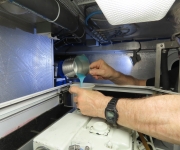
Over the last few months the generator running temperature has been slowly increasing. We were still below the 205F cut-off level, and the generator continued to run fine, but something clearly wasn’t right. The generator normally runs in the 192F to 193F range at full load and I have a warning set at 195 that…

We’ve had three pendants fail on our Steelhead Marine crane over the last 9 years. The proportional switch proximity sensor is very fragile but there are other failure points as well. These pendants cost just under $1000 each, so we really needed a longer lasting and more economical solution. Steelhead does sell a remote-control for this crane,…
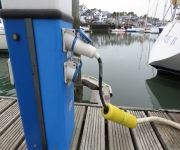
Isolating shore power from on-board electrical systems is important to avoid excess corrosion and, even more importantly, to avoid risk of shock in and around the boat. Two common approaches to isolation are galvanic isolators and isolation transformers. Isolation transformers have many advantages and often are installed in Nordhavns, but have one potential downside though:…
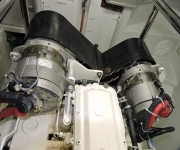
On Dirona, we aim to always run the boat using a single power source. When we are plugged into shore, we aim to drive the entire boat off of shore-side power and never run the generator. This may sound easy, but in Europe you frequently won’t find more than a 16A shore power service and…
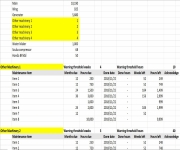
A few years back we posted the Excel-based spreadsheet we wrote for our maintenance log, along with instructions on how to use it. The spreadsheet has continued to serve us well, and still is our main tool for managing maintenance items. While it’s fairly easy to add new maintenance items for a given piece of…

It’s hard to believe, but our “new” John Deere 6068AFM75 is now nearly 9 years old, has been around the world, and has now clocked up over 10,000 engine hours: Hours: 10075.1 Nautical miles traveled: 69,187 Fuel burn: 59,257.4 gallons Load factor: 44.2% Longest ocean crossing: 3,689 nautical miles (St. Helena to Barbados) Over the…
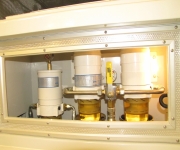
When considering fuel quality, we’ve always thought first about water, rust, and other impurities in the fuel. Knowing we intended to travel the world and expecting poor quality fuel in the many less-developed countries we would visit, we left Seattle with 48 primary filters on board. What we have learned is that fuel quality is…

We completed a number of boat projects in Trondheim, including replacing a steering pump and the nav computer. Most were waiting on gear sourced on our return trip to Seattle—we spent much of the ten days after the trip installing and stowing parts. Below are highlights from July 14th through August 14th in Trondheim, Norway….
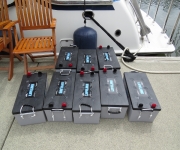
Most battery manufacturers specify battery life expectancy in terms of number of cycles at a certain maximum discharge level. Transforming this data into the expected or remaining battery life for a house bank is challenging. In measuring the number of cycles, for example, what depth of discharge qualifies as a “cycle”? Our house bank consists…
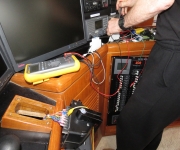
We didn’t spend all our time in London socializing and taking in the sights. We also completed a number of projects, for the boat, the web site, ourselves and even Spitfire. Below are highlights from Feb 13th through April 12th in London, UK. Click any image for a larger view, or click the position to…
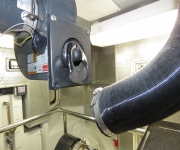
The dry exhaust system on Dirona is well-built and reliable. The way it works is the stack heads up through the boat in a 5-inch pipe to release exhaust gas at the top of the stack. The exhaust pipe is enclosed in a larger pipe where it passes through the boat. This larger pipe provides…
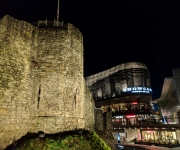
Prior to the thirty-one days in Southampton, the longest time we’d ever been in the yard was ten days. During our month-long Southampton yard trip we completed three major projects: replacing the muffler, rebuilding the crane, and replacing the cutlass bearings on the rudder shaft and the wing and main propeller shafts. We also completed…

The final major project we completed at Saxon Wharf in Southampton was replacing the cutlass bearings on the rudder shaft and the wing and main propeller shafts. On inspection after removing the cutlass bearing, our main propeller shaft was badly corroded with some of the pits running quite deep, so we opted to replace it…
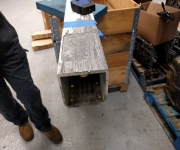
A second major project that we completed while in the yard at Southampton was to rebuild our crane. It was in remarkably poor condition. The ram-to-extension bolts were siezed due to lack of Tuff-Gel application on the stainless screws in the aluminum casting; the linear winch had worn away all its bearing material, damaging the…

We had a long list of projects to complete during our Southampton haulout at Saxon Wharf. One of the bigger jobs was to replace the muffler. Our old one turned out to not be in bad shape, and might have gone a few more years. But we couldn’t really know the state of the muffler…
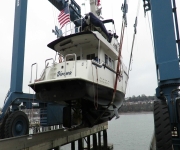
Boats have been damaged or destroyed during lift operations, so we’re always nervous whenever we haul Dirona out. We were impressed with the care Saxon Wharf took in the lift, including asking for exterior hull photos to could assess where to place the lifting straps. The operation went smoothly and by mid-morning we were safely…